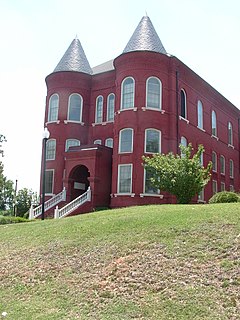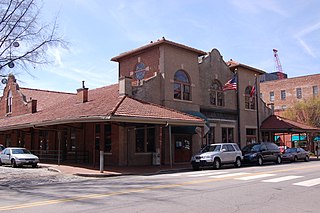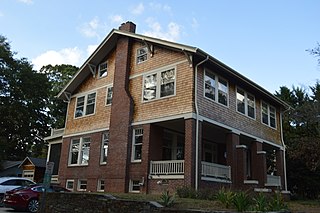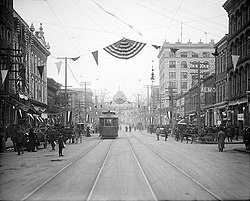
The Capitol Area Historic District is a national historic district located at Raleigh, North Carolina. The district encompasses 25 contributing buildings and was developed after 1792. The district includes notable examples of Classical Revival and Late Gothic Revival style architecture. Located in the district are the following separately listed buildings:

The East Raleigh–South Park Historic District is the largest African-American neighborhood in Raleigh, North Carolina. The district, located south and east of downtown Raleigh, covers approximately 30 blocks and contains portions of the Smith–Haywood and St. Petersburg neighborhoods. Most homes in these neighborhoods were built between 1900 and 1940, with one-fifth dating back to the 19th century. Historic buildings in the district include Estey Hall and Leonard Hall, both located on the campus of Shaw University. The district was listed on the National Register of Historic Places in October 1990.

The Moore Square Historic District is a registered historic district located in downtown Raleigh, North Carolina. Listed on the National Register of Historic Places in 1983, the district is centered on Moore Square, one of two surviving four-acre parks from Raleigh's original 1792 plan. The park is named after Alfred Moore, a North Carolina judge who became an Associate Justice on the Supreme Court. Originally a residential neighborhood, Moore Square developed into a primary commercial hub in the city throughout the late 19th and early 20th centuries. The district includes East Hargett Street, once known as Raleigh's "Black Main Street", because it once contained the largest number of businesses owned by African-Americans in the city. City Market, Marbles Kids Museum/IMAX theatre, Pope House Museum, Artspace, and the Long View Center are located in the Moore Square district. Events that take place in Moore Square include the Raleigh Arts Festival, Artsplosure, Movies in the Park, the Street Painting Festival, and the Moore Square Farmer's Market The approximate district boundaries include Person, Morgan, Wilmington, and Davie Streets.

The West Raleigh Historic District in Raleigh, North Carolina is a national historic district listed on the National Register of Historic Places in 2003. Located 1.5 miles (2.41 km) west-northwest of the State Capitol, the district encompasses approximately 332 acres (134 ha). Neighborhoods in the district include: Bedford Heights, Bagwell, Blue Moon Ridge, College Crest, Fairmont, Forest Hills, Harris-Chamberlain, and Wilmont. Most homes in these neighborhoods are one-story and were constructed between the 1930s to 1950s. While the district is mostly residential, churches and commercial buildings are common along Hillsborough Street.

The Depot Historic District is an industrial and commercial neighborhood in downtown Raleigh, North Carolina that was the city's railroad and warehouse distribution hub from the 1850s to 1950s. Located two blocks west of Fayetteville Street and to the north and east of the Norfolk and Southern railroad tracks, the district contains four blocks of 35 brick buildings that date from the 1880s to early 1950s. The district encompasses the southwestern portion of Raleigh's original 1792 town plan and was listed on the National Register of Historic Places in 2002.

The Lumsden–Boone Building is a historic commercial building located at 226 Fayetteville Street in the Fayetteville Street Historic District of Raleigh, North Carolina, United States. Constructed in 1896 for tin and hardware dealer J.C.S. Lumsden, the building is the only surviving metal-front building today on Fayetteville Street. Boone's official business name was "C.R. Boone, DeLuxe Clothier"; his was considered one of the city's leading businesses and boasted the slogan "Come and See". The Lumsden–Boone Building is currently used by a web design company. The building was added to the National Register of Historic Places on September 8, 1983, and was renovated in 1985 and in 2008.

Saint Mary's School is a private independent Episcopal college-preparatory, boarding and day school for girls in grades 9–12. Located in Raleigh, North Carolina, Saint Mary's School operates as an independent school with a historic association with the Episcopal Church including an Episcopal chapel, St. Mary's Chapel, on the school's grounds. The school formerly operated as Saint Mary's College and for many decades educated young women in grades 11–12 and their freshman and sophomore years in college. The school changed to a four year high school in 1998, at which point the name reverted to Saint Mary's School, the original name of the institution when it was founded in 1842.
Fayetteville Historic District may refer to:
Benton & Benton was an architectural partnership in eastern North Carolina of brothers Charles C. Benton Sr. and Frank W. Benton. Several of its works are listed on the U.S. National Register of Historic Places. Charles C. Benton Jr. and others also worked for the firm.

Cameron Park is a historic neighborhood just west of downtown Raleigh, North Carolina, one of three suburbs platted in the early 20th century. Development began along Hillsborough Street and moved north; a streetcar line along Hillsborough made the location especially appealing and convenient. Cameron Park's developers used restrictive deed covenants that set minimum house prices, created setbacks from the street, and excluded African Americans from living in the neighborhood. Advertisements for Cameron Park openly recruited socially ambitious upper-middle class residents to the neighborhood, and land and house values were significantly higher than those of other early suburbs.

The Roanoke Park Historic District a national historic district located at Raleigh, North Carolina. It is one of the city's historic Five Points neighborhoods and encompasses 446 contributing buildings and 1 contributing site. It is situated southeast of the Five Points intersection of Glenwood Avenue and Fairview and Whitaker Mill Roads. Roanoke Park is composed of six separate plats, filed from 1913 to 1926, and is roughly shaped like a diamond.

The Battery Heights Historic District is a historic neighborhood and national historic district located southeast of downtown Raleigh, North Carolina, USA. Named for the earthen batteries stationed in the area during the Civil War, the neighborhood has a suburban character, despite its close proximity to the city center.

Charles C. Hartmann (1889–1977) was an American architect.

The Hi-Mount Historic District is a historic neighborhood located two miles north of downtown Raleigh, North Carolina, United States. The eleven-block district, developed between 1938 and 1951, is one of the city's best-preserved twentieth century speculative neighborhoods. The district encompasses 168 contributing buildings and 1 contributing site. Most of Hi-Mount's homes are Minimal Traditional in style, followed by Cape Cod and Ranch homes with sparse detailing. A small number of developers were involved with the district and the district also benefited from government housing financing programs such as the Federal Housing Administration and the Veteran's Administration, resulting in architectural consistency throughout the neighborhood.
Louis H. Asbury (1877–1975) was an American architect, a leading architect of Charlotte, North Carolina. He is asserted to be the "first professionally trained, fulltime architect in North Carolina who was born and practiced in the state."
Leslie N. Boney Sr. (1880–1964) was an American architect who focused on schools. He designed approximately 1,000 schools or additions to schools, and his works appear in 51 of North Carolina's 100 counties.
Willard Close Northup (1882–1942) was an American architect in North Carolina, who was the principal partner in the firm Northup & O'Brien. His firm was based in Winston-Salem, North Carolina. Northup began his architectural practice in 1906 and partnered with Leet Alexander O'Brien (1891–1963) in 1915 or 1916. Luther Lashmit joined the firm in 1927, and was lead architect for Graylyn while an employee of the firm.

Longview Gardens Historic District is a historic post-World War II neighborhood and national historic district located 1 1/2-miles east of downtown Raleigh, North Carolina. The district encompasses 189 contributing buildings and five contributing sites. Notable contributing resources include the Raleigh Country Club golf course designed by Donald Ross, Longview Baptist Church and Milner Memorial Presbyterian Church (1946), both striking examples of Modernist architecture.

















